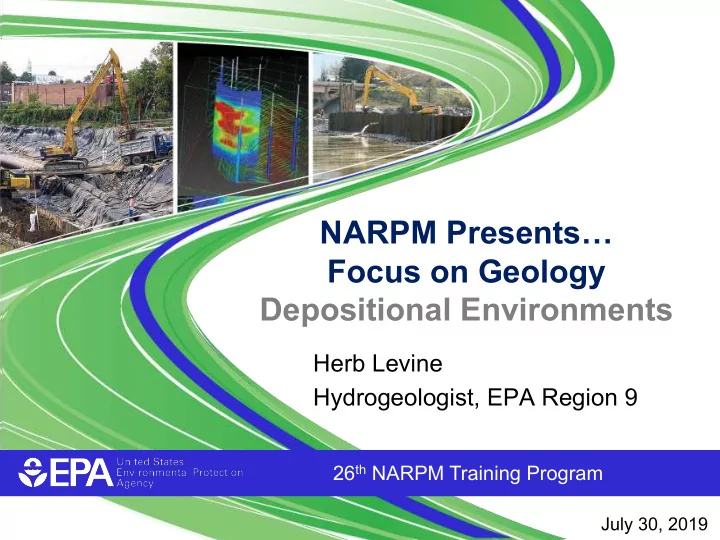

NARPM Presents… Focus on Geology Depositional Environments Herb Levine Hydrogeologist, EPA Region 9 26 th NARPM Training Program July 30, 2019
Depositional Environments Introduction • Why is this important or relevant? • Impacts to identification of flowpaths and contaminant transport • Decrease uncertainty and increase potential for a successful remedy • Applications and case study will be presented at NARPM 2019. 26 th NARPM Training Program 1
Depositional Environments ► 90% of mass flux contaminant transport at Superfund sites has been shown to be through 10% of aquifer material. ► A site conceptual model that accurately reflects the geologic plumbing is essential for remedy selection and implementation. ► selection/design and unnecessarily lengthy cleanups. Site conceptual models that do not consider depositional environment tend to incorrectly interpret the geologic plumbing which leads to faulty remedy 26 th NARPM Training Program 2
Depositional Environments ► Identify groundwater flow paths and preferential contaminant migration pathways ► Map and predict contaminant mass transport (high permeability) zones and matrix diffusion-related storage (low permeability) zones ► Identify data gaps and determine a focused HRSC program, if needed ► Optimize groundwater monitoring program ► Improve efficiency and timeliness of remediating contaminated groundwater ► Reduce cost of remediation 26 th NARPM Training Program 3
26 th NARPM Training Program 4
Pattern Recognition Depositional environments have distinctive vertical grain size distributions 26 th NARPM Training Program 5
Pattern Recognition Glacial depositional systems Alluvial fan facies model Meandering river facies model Coastal depositional systems 26 th NARPM Training Program 6
The Environmental Sequence Stratigraphy (ESS) Process 1 2 3 Grain-size increasing Gravel Clay 0 100 Unconf Depth (Ft - MSL) 200 300 Unconf 400 Determine Leverage existing Map and predict in 3-D depositional lithology data: format the subsurface environment , which is to emphasize vertical conditions away from the foundation of the grainsize distribution the data points ESS evaluation 26 th NARPM Training Program 7
Focus on Depositional Environments 26 th NARPM Training Program 8
Sedimentary Environments control: • The energy required to move the particle(s) • The distance travelled by the particle(s) • The source of sediment, the location of sedimentation 26 th NARPM Training Program 9
Sedimentary Processes Flowchart: • Source Material • Weathering • Transport • Deposition • Diagenesis 26 th NARPM Training Program 10
A summary of the principal sedimentary environments Nichols, 2009 26 th NARPM Training Program 11
The pathway of processes involved in the formation of a succession of clastic sedimentary rocks, part of the rock cycle. 26 th NARPM Training Program 12
Glacial landforms and glacial deposits in continental glaciated areas 26 th NARPM Training Program 13
The geomorphologi cal zones in alluvial and fluvial systems: in general braided rivers tend to occur in more proximal areas and meandering rivers occur further downstream. 26 th NARPM Training Program 14
Several types of river can be distinguished, based on whether the river channel is straight or sinuous (meandering), has one channels or multiple (anastomosin g), and has in-channel bars (braided). Combination s of these forms can often occur. 26 th NARPM Training Program 15
Types of alluvial fan: debris-flow dominated, sheet flood and stream-channel types – mixtures of these processes can occur on a single fan. 26 th NARPM Training Program 16
Differences in the grain size of the sediment supplied affect the form of a delta: (a) a high proportion of suspended load results in a relatively small mouth bar deposited from bedload and extensive delta-front and prodelta deposits (b) a higher proportion of bedload results in a delta with a higher proportion of mouth bar gravels and sands. 26 th NARPM Training Program 17
(a)A delta prograding into shallow water will spread out as the sediment is redistributed by shallow- water processes to form extensive mouth-bar and delta-front facies. (b)In deeper water the mouth bar is restricted to an area close to the river mouth and much of the sediment is deposited by mass-flow processes in deeper water. 26 th NARPM Training Program 18
Depositional environments on a submarine fan. 26 th NARPM Training Program 19
Principles of superposition: (a) a ‘layer-cake’ stratigraphy; (b) stratigraphic relations around a reef or similar feature with a depositional topography. 26 th NARPM Training Program 20
Gaps in the record are represented by unconformities: (a) angular unconformities occur when older rocks have been deformed and eroded prior to later deposition above the unconformity surface; (b) disconformities represent breaks in sedimentation that may be associated with erosion but without deformation. 26 th NARPM Training Program 21
General Benefits of ESS Approach ► Identify groundwater flow paths and preferential contaminant migration pathways ► Map and predict contaminant mass transport (high permeability) zones and matrix diffusion-related storage (low permeability) zones ► Identify data gaps and determine a focused HRSC program, if needed ► Optimize groundwater monitoring program ► Improve efficiency and timeliness of remediating contaminated groundwater ► Reduce cost of remediation 26 th NARPM Training Program 22
Recommend
More recommend